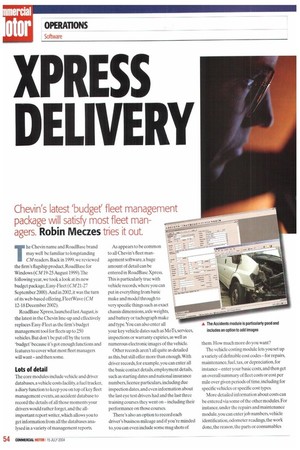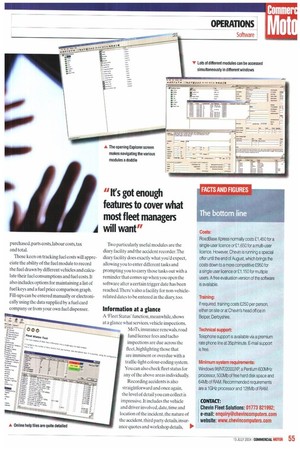)(PRESS DELIVERY
Page 54

Page 55

Page 56

Page 57

If you've noticed an error in this article please click here to report it so we can fix it.
Chevin's latest 'budget' fleet management package will satisfy most fleet man
agers. Robin Meczes tries it out.
The Chevin name and RoadBase brand may well be familiar to longstanding CM readers. Back in 1999, we reviewed the firm's flagship product, RoadBase for Windows (CM 19-25 August 1999).The following year, we took a look at its new budget package, Easy-Fleet (CM21-27 September 2000).And in 2002, it was the turn of its web-based offering, Fleet Wave (CM 12-18 December 2002).
RoadBase Xpress,launched last August, is the latest in the Chevin line-up and effectively replaces Easy-Fleet as the firm's budget management tool for fleets up to 250 vehicles. But don't be put off by the term 'budget' because it's got enough functions and features to cover what most fleet managers will want — and then some.
Lots of detail
The core modules include vehicle and driver databases, a vehicle costs facility, a fuel tracker, a diary function to keep you on top of key fleet management events, an accident database to record the details of all those moments your drivers would rather forget.and the allimportant report writer, which allows you to get information from all the databases analysed in a variety of management reports. As appears to be common to all Chevin's fleet management software, a huge amount of detail can be entered in RoadBase Xpress. This is particularly true with vehicle records, where you can put in everything from basic make and model through to very specific things such as exact chassis dimensions, axle weights, and battery or tachograph make and type.You can also enter all your key vehicle dates such as MoTs, services, inspections or warranty expiries, as well as numerous electronic images of the vehicle.
Other records aren't all quite as detailed as this, but still offer more than enough. With driver records, for example, you can enter all the basic contact details, employment details, such as starting dates and national insurance numbers, licence particulars, including due inspection dates, and even information about the last eye test drivers had and the last three training courses they went on — including their performance on those courses.
There's also an option to record each driver's business mileage and if you're minded to, you can even include some mug shots of them. How much more do you want?
The vehicle costing module lets you set up a variety of definable cost codes — for repairs, maintenance, fuel, tax, or depreciation, for instance — enter your basic costs, and then get an overall summary of fleet costs or cost per mile over given periods of time,including for specific vehicles or specific cost types.
More detailed information about costs can be entered via some of the other modules. For instance, under the repairs and maintenance module, you can enter job numbers, vehicle identification, odometer readings, the work done, the reason, the parts or consumables purchased, parts costs, labour costs, tax and total.
Those keen on tracking fuel costs will appreciate the ability of the fuel module to record the fuel drawn by different vehicles and calculate their fuel consumptions and fuel costs. It also includes options for maintaining a list of fuel keys and a fuel price comparison graph. Fill-ups can be entered manually or electronically using the data supplied by a fuel card company or from your own fuel dispenser. Two particularly useful modules are the diary facility and the accident recorder.The diary facility does exactly what you'd expect, allowing you to enter different tasks and prompting you to carry those tasks out with a reminder that comes up when you open the software after a certain trigger date has been reached.There's also a facility for non-vehiclerelated dates to be entered in the diary, too.
Information at a glance
A 'Fleet Status' function, meanwhile, shows at a glance what services, vehicle inspections, MoTs, insurance renewals., road fund licence fees and tacho inspections are due across the fleet, highlighting those that are imminent or overdue with a traffic-light colour-coding system.
You can also check fleet status for any of the above areas individually.
Recording accidents is also straightforward and once again, the level of detail you can collect is impressive. It includes the vehicle and driver involved, date, time and location of the incident, the nature of the accident, third party details, insurance quotes and workshop details, 1110' police involvement and a cost summary. Once again, electronic images of vehicles can be appended.There's even a useful link front the accident record screen to the diary module to encourage you to enter tasks related to processing the accident there, such as chasing up your insurance company for a cheque.
Leaving all the functionality to one side, the software is mostly quite straightforward to use.The opening 'Explorer' screen, which gives access to all the modules, is intui , tive and comfortingly similar I a .1 to Windows Explorer. Moving around the software is nice and easy as you can open different modules in different windows and keep them all open at once, switching between them as necessary. In addition to the Explorer screen, you can access different modules via an icon-driven overhead toolbar or drop-down menus.And entering and accessing data in all the modules is generally a doddle.
If you do get stuck anywhere, there are some pretty detailed online help pages to consult. And there's also a nice built-in back-up utility that compresses all your data files and stores them in the location of your choice — though it's perhaps a shame this cannot be set for automatic backups.
It has to be said that as with Chevin 's other packages, there are some slightly quirky interface characteristics to be dealt with. If you try entering 1/7/2004 as a date,for instance, it won't recognise or retain it; you have to type 01/07/2004 instead. If you call up a list of vehicles and double click on one,you get all its details popping up but you can't just 'Escape' to go back to the list you need to use a special 'toggle view' button on the toolbar instead. And we never really even started to get to grips with the report writing process, which we found far from instinctive to use.
Other than this, however, there is little to complain about. One of the users we spoke to mentioned frequent system crashes (see 'User views'), which reminded us of our own experiences with some of Chevin's older software -but all we can say is that with the exception of a couple of times where the software threw us out and closed itself down. RoadBase Xpress behaved itself during our test.
Conclusion
Overall, while this software doesn't have too many frills, it still delivers a sound range of features and functions at a reasonable price. You might feel you need the additional functionality offered in the full RoadB ase package, such as stock and workshop modules or the ability to redesign all the screen layouts. But unless you do.RoadBase Xpress is a capable and reasonably priced alternative to its bigger brother -as well as a number of competitor packages. •






































































































































































































